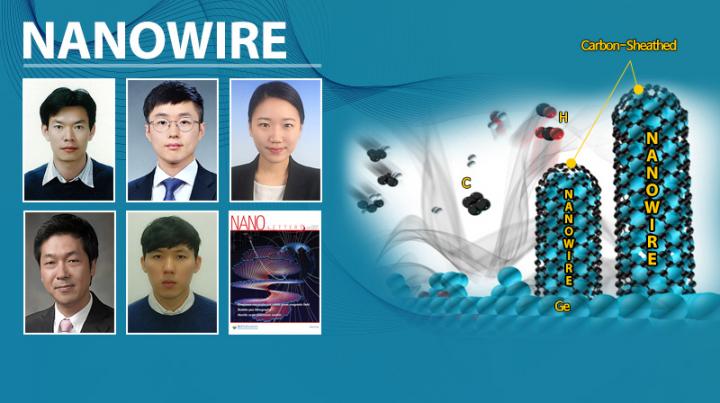New type of nanowires, built with natural gas heating

From top left are Professor Soojin Park, Dr. Sinho Choi, researcher Jieun Kim (KRICT) and from bottom left are Professor Sang Kyu Kwak and researcher Dae Yeon Hwang. UNIST. Contents by: Sinho Choi, Design by: Dukgi Lee
A team of Korean researchers, affiliated with UNIST has recently pioneered in developing a new simple nanowire manufacturing technique that uses self-catalytic growth process assisted by thermal decomposition of natural gas. According to the research team, this method is simple, reproducible, size-controllable, and cost-effective in that lithium-ion batteries could also benefit from it.
In their approach, they discovered that germanium nanowires are grown by the reduction of germanium oxide particles and subsequent self-catalytic growth during the thermal decomposition of natural gas, and simultaneously, carbon sheath layers are uniformly coated on the nanowire surface.
This study is a collaboration among scientists, including Prof. SooJin Park (School of Energy and Chemical Engineering) and Prof. Sang Kyu Kwak (School of Energy and Chemical Engineering), Dr. Sinho Choi (UNIST), Combined M.S./Ph.D. Student Dae Yeon Hwang (UNIST), and Researcher Jieun Kim (Korea Research Institute of Chemical Technology).
In a study, reported in the January 21, 2016 issue of Nano Letters, the team demonstrated a new redox-responsive assembly method to synthesize hierarchically structured carbon-sheathed germanium nanowires (c-GeNWs) on a large scale by the use of self-catalytic growth process assisted by thermally decomposed natural gas.
According to the team, this simple synthetic process not only enables them to synthesize hierachially assembled materials from inexpensive metal oxides at a larger scale, but also can likely be extended to other metal oxides as well. Moreover, the resulting hierarchically assembled nanowires (C-GeNWs) show enhanced chemical and thermal stability, as well as outstanding electrochemical properties.
The team states, “This strategy may open up an effective way to make other metallic/semiconducting nanomaterials via one-step synthetic reactions through an environmentally benign and cost-effective approach.”
###
This work was supported by the Basic Science Research Program and Mid-Career Research Program through the National Research Foundation of Korea (NRF) grand, funded by the Korean government (MSIP).
Journal Reference: Sinho Choi, Jieun Kim, Dae Yeon Hwang, Hyungmin Park, Jaegeon Ryu, Sang Kyu Kwak* and Soojin Park* “Generalized redox-responsive assembly of carbon-sheathed metallic and semiconducting nanowire heterostructures”. Nano Lett. (2016)
Media Contact
All latest news from the category: Physics and Astronomy
This area deals with the fundamental laws and building blocks of nature and how they interact, the properties and the behavior of matter, and research into space and time and their structures.
innovations-report provides in-depth reports and articles on subjects such as astrophysics, laser technologies, nuclear, quantum, particle and solid-state physics, nanotechnologies, planetary research and findings (Mars, Venus) and developments related to the Hubble Telescope.
Newest articles

Superradiant atoms could push the boundaries of how precisely time can be measured
Superradiant atoms can help us measure time more precisely than ever. In a new study, researchers from the University of Copenhagen present a new method for measuring the time interval,…

Ion thermoelectric conversion devices for near room temperature
The electrode sheet of the thermoelectric device consists of ionic hydrogel, which is sandwiched between the electrodes to form, and the Prussian blue on the electrode undergoes a redox reaction…

Zap Energy achieves 37-million-degree temperatures in a compact device
New publication reports record electron temperatures for a small-scale, sheared-flow-stabilized Z-pinch fusion device. In the nine decades since humans first produced fusion reactions, only a few fusion technologies have demonstrated…





















